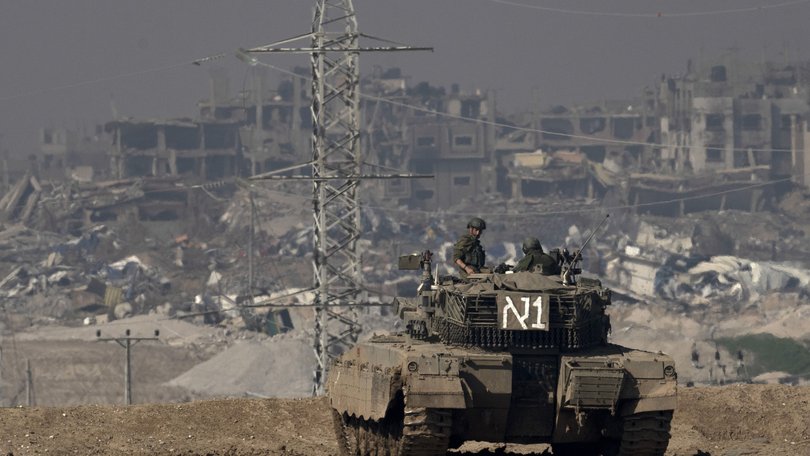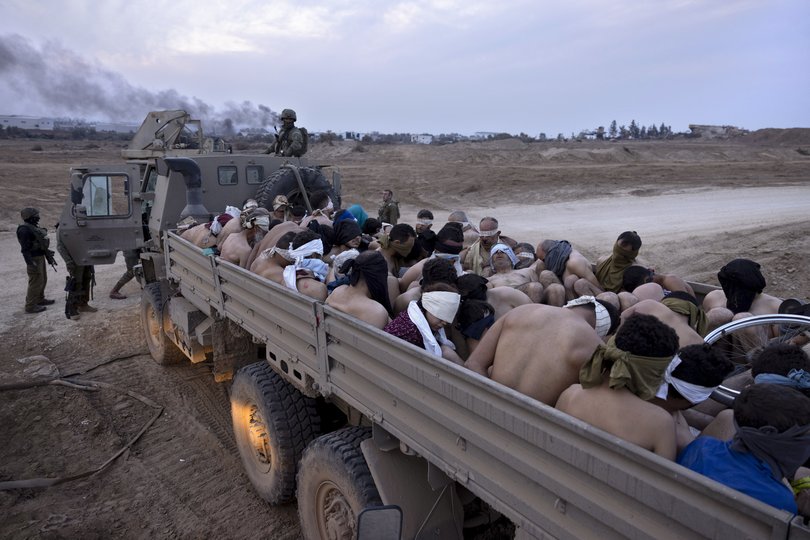THE NEW YORK TIMES: Gaza ceasefire deal gains momentum ahead of Trump inauguration

High-level ceasefire talks appear to be gaining momentum as Arab and US mediators pressed for an agreement to halt the fighting in the Gaza Strip and release hostages held by Hamas before President-elect Donald Trump assumes office on Jan. 20.
It was still unclear whether the parties had reached a resolution on all the central disputes that have proved insurmountable in previous rounds of negotiations, but officials expressed optimism that a deal was achievable.
On Monday local time, President Joe Biden suggested an agreement between Israel and Hamas was imminent. “On the war between Israel and Hamas, we’re on the brink of a proposal that I laid out in detail months ago finally coming to fruition,” he said in a foreign policy speech.
Sign up to The Nightly's newsletters.
Get the first look at the digital newspaper, curated daily stories and breaking headlines delivered to your inbox.
By continuing you agree to our Terms and Privacy Policy.Jake Sullivan, the US national security adviser, said there was “a distinct possibility” that Hamas and Israel could agree to a deal this week.
“The question is now can we all collectively seize the moment and make this happen,” he told Bloomberg in an interview.
A Hamas official said in a text message that progress had been made on all issues and that a deal was possible in the coming two days as long as Israel does not change its position at the last minute.
Earlier Monday, an Arab diplomat said “real progress” was being made in the talks, and two Israeli officials said a draft agreement was awaiting Hamas’ approval, with the next 24 hours seen as being critical.
Other Israeli officials said the optimal conditions for an agreement had been created, making a breakthrough possible. These officials said the emerging agreement would allow Israel to maintain a buffer zone in Gaza during its implementation and that Israeli forces would not leave the territory until all hostages were released.
They also said it would allow displaced Palestinians in southern Gaza to return to the north while unspecified “security arrangements” were enforced.
The Hamas official, the diplomat and the Israeli officials spoke on the condition of anonymity to discuss sensitive diplomacy.
For months, repeated rounds of talks have seen hopes rise only to be dashed days later, with Israel and Hamas each blaming the other for the impasse.
If a deal is achieved, it would bring some respite to Palestinians in Gaza, who have endured miserable conditions in displacement camps and relentless bombardments by Israel, and the families of hostages taken from Israel, who have suffered for months wondering about the fate of their loved ones.

Who are the players?
— The lead mediators in the talks are Qatar and Egypt, shuttling messages between Israel and Hamas. The Qatari prime minister, Sheikh Mohammed bin Abdulrahman bin Al Thani, and the director of Egypt’s General Intelligence Service, Maj. Gen. Hassan Rashad, have been the top officials representing their countries in the negotiations.
— David Barnea, the chief of Israel’s foreign intelligence service, Mossad, is one of Israel’s main negotiators, alongside Ronen Bar, the head of the Shin Bet, a domestic security service, and Maj. Gen. Nitzan Alon of the Israeli military. Ophir Falk, a foreign policy adviser to Prime Minister Benjamin Netanyahu, has also participated in important meetings related to the negotiations.
— Khalil al-Hayya, a senior Hamas official based in Doha, Qatar, is the militant group’s chief negotiator and has interfaced with Qatari and Egyptian officials about the details of a possible agreement.
— The United States has used its leverage to encourage Israel and Hamas to sign on to a deal. CIA Director William Burns and Brett McGurk, a senior White House official, have crisscrossed the Middle East, pressing for a breakthrough in the talks. Steve Witkoff, Trump’s Middle East envoy, has also made trips to Qatar and Israel, meeting with top officials there.
What are they negotiating?
— Israeli officials hope to secure the release of at least some of the roughly 100 hostages who have been held in Gaza since the Hamas-led attack on southern Israel on Oct. 7, 2023, that ignited the war.
— Hamas leaders want to bring about an end to the Israeli assault, which has severely weakened the group’s armed wing and government, uprooted nearly 2 million people, and reduced cities to rubble. Hamas officials have also said they are seeking a complete Israeli withdrawal from Gaza, the return of displaced people in the south of the enclave to the north, the entry of materials for reconstruction, and freedom for Palestinian prisoners held in Israel. On Monday, Hamas said in a statement that Palestinian prisoners would be freed soon.
— The parties have long been discussing an agreement that would have three stages in what Arab and U.S. officials hope will result in the end of the war. But Israeli officials said Monday that the deal coming together could have only two phases, with negotiations about the details of the second stage commencing on the 16th day of the first stage.
What are the biggest obstacles?
— A major hurdle to the success of the talks has been the permanency of a ceasefire. While Hamas has demanded a comprehensive end to the war, Netanyahu has said he wants a “partial” deal that would allow Israel to resume the war after freeing hostages.
— Israel has been demanding vague language in the text of an agreement that leaves room for a resumption of fighting at some point, according to a Palestinian familiar with the matter and two Israeli officials. Netanyahu has feared that his right-wing coalition partners could take down his government and jeopardize his political future if he agrees to a deal that ends the war, analysts say.
— In a post on the social platform X on Monday, Israeli Finance Minister Bezalel Smotrich described “the emerging deal” as “a catastrophe for the national security” of Israel and declared he would not support it.
— Hamas has not suggested that it would be willing to compromise on its demand to end the war. Osama Hamdan, a senior Hamas official, said at a gathering in Algeria last week that there must be “an absolute end to the aggression.”
— Another hurdle has been how far into Gaza Israel will be allowed to carry out military operations in the first phase of an agreement. Israel had wanted the ability to maneuver up to 1.5 kilometers, or about a mile, into the enclave, the two Israeli officials and the Palestinian familiar with the matter said. Hamas had wanted any incursions limited to within 500 meters of the border, according to the Palestinian.
— The Israeli officials, however, have now been saying that the emerging agreement would allow Israel to maintain a buffer zone in Gaza during its implementation and that Israeli forces would not leave the territory until all hostages were released.
— Israel has demanded a list from Hamas of which hostages are still alive. Without that, Israeli officials say, there can be no agreement on how many Palestinian prisoners Israel would be willing to release in exchange. As of Sunday morning, Israel had not received such a list, according to an official familiar with the matter.
— Last week, Hamas representatives indicated that the group had approved an Israeli list of 34 hostages to be released in the first stage of an agreement, but it did not specify how many of them were alive. On Wednesday, Israeli authorities announced that the body of one of the hostages whose name appeared on the list— Youssef Ziyadne, 53, an Arab citizen of Israel — had been found in Gaza.
— On Monday, Israeli officials confirmed that the number of hostages to be released in the first stage was 33 and said their assessment was that most of them were alive.
— But Hamas has agreed to Israel’s request to include 11 contested individuals on the list of hostages to be released in the first phase of a deal. Israel classifies them as civilians, but Hamas considers them soldiers, according to the two Israeli officials and the Palestinian. Israel is weighing Hamas’ demand that the 11 be treated as soldiers who would be exchanged for a higher number of Palestinian prisoners than those released for civilian hostages.
This article originally appeared in The New York Times.
© 2025 The New York Times Company
Originally published on The New York Times
